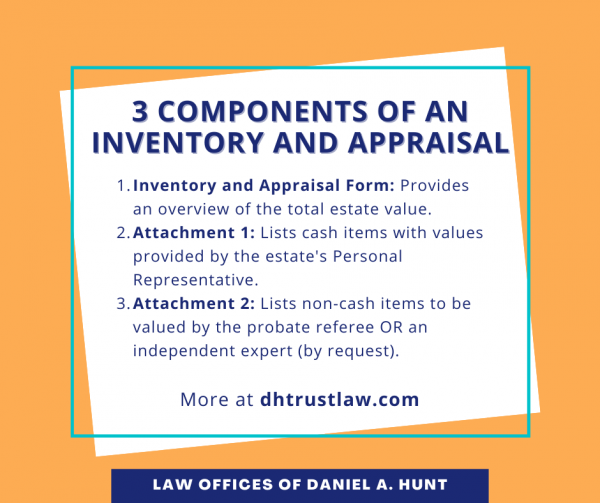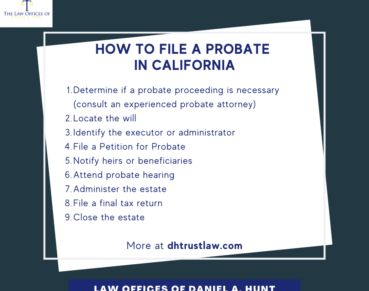Inventory and Appraisal in a Probate

If you’re the Personal Representative in a probate estate, you must file a document called Inventory and Appraisal with the court within four months of receiving Letters of Administration. Inventory and Appraisal is a single document that lists all of the estate’s assets and appraises the value of those assets. The purpose of the Inventory and Appraisal is to determine the value of the decedents’ assets at the date of their death. Ultimately, the appraisal values set forth in the Inventory and Appraisal will set the base values for determining the statutory fees to be paid at the end of the probate matter.
What to Include in the Inventory
The Inventory and Appraisal form provides an overall estate value, while the attachment forms provide an itemized list of the estate assets.
The Inventory should include all of the decedent’s assets, such as real property; cash, checking, savings, and investment accounts; household furniture; jewelry; collectibles such as coin collections, antiques, and record collections; business interests, and any other assets.
Describe each item in detail so that it can be properly identified and appraised, including account numbers, legal descriptions, license numbers, etc. Be sure to clearly designate each item as the decedent’s separate property or the decedent’s one-half interest as community property of the decedent and their surviving spouse.
The Inventory and Appraisal form requires two attachments: Attachment 1 and Attachment 2.
Assets Appraised by the Personal Representative
As Personal Representative, you will appraise the items on Attachment 1, as outlined in Probate Code section 8901. These include cash assets, such as:
- Money and other cash items issued on or before the date of the decedent’s death.
- Checks issued after the date of the decedent’s death such as checks for wages earned before death, refund checks (like tax and utility refunds or Medicare, medical insurance, and other health care reimbursements and payments).
- Accounts in financial institutions.
- Cash deposits and money market mutual funds, including brokerage cash accounts.
- Proceeds of life and accident insurance policies and retirement plans and annuities payable on death in lump sum amounts.
For each item, list the dollar value as of the decedent’s date of death.
Assets Appraised by the Probate Referee
Attachment 2 will list non-cash assets where value may be harder to determine which must be appraised by the probate referee. Probate referees are qualified appraisers who have passed rigorous requirements and been appointed by the California State Controller’s Office.
Assets to be appraised by the probate referee include:
- Real property
- Stocks, bonds, mutual funds, and other securities
- Tangible personal property such as automobiles; partnership and business interests
- Household furniture and furnishings (can be listed collectively rather than individually)
Include a blank space after each of these items so they can be appraised and completed by the probate referee. The probate referee should return the completed Inventory & Appraisal with the asset values within 60 days (unless they request additional information from you).
After the probate referee has signed Attachment 2, you must file the Inventory and Appraisal and two attachments with the probate court.
Assets Appraised by an Independent Expert
Probate Code section 8904 states that the personal representative can elect to have an independent expert appraise a “unique, artistic, unusual, or special item of tangible personal property”. To do this, make a notation on Attachment 2 that the item will be appraised separately. Within 5 days of the inventory’s delivery, the probate referee may petition for a court determination of whether the item qualifies as “unique, artistic, unusual, or special”.
However, be careful with making this request. If the petition fails and the court determines the petition wasn’t justified, you may need to pay the probate referee’s attorney fees.
Partial, Amended, and Supplemental Inventories
If you are able to list all of the estate assets on one Inventory and Appraisal form, write “Final” at the top of the form.
If you know that some assets are still missing after four months of receiving Letters, file an Inventory & Appraisal and write “Partial” at the top of the form. Later, when the last of the assets have been inventoried, you can file a “Final” Inventory.
If you file a “Final” Inventory and later discover additional estate assets, you should file a “Supplemental” Inventory with those assets.
If you discover that any of the items listed on a previous Inventory were incorrect (such as an account number or legal description), file a “Corrected” Inventory to fix the error.
Paying the Probate Referee
Be aware that probate referees do charge a fee for their service. In California, the statutory fee is one-tenth of 1% (.001) of the total assets they appraise. This fee only applies to assets listed on Attachment 2 (non-cash assets). The probate referee can also charge for mileage. The minimum probate referee fee is $75 and the maximum fee is $10,000.
If the only estate asset is real estate and the beneficiaries wish to keep this asset, they will either need to pay the probate referee themselves or consider selling the real property to pay for this fee and other fees involved in the probate (including the statutory fees paid to the attorney and the personal representative). Also, keep in mind, if you have to submit additional assets to the referee to amend or supplement an appraisal, the referee may charge an additional fee for the valuation of those assets.
If you have any questions about how to handle Inventory and Appraisal in a probate, feel free to contact our law firm.
Law Offices of Daniel A. Hunt
The Law Offices of Daniel A. Hunt is a California law firm specializing in Estate Planning; Trust Administration & Litigation; Probate; and Conservatorships. We've helped over 10,000 clients find peace of mind. We serve clients throughout the greater Sacramento region and the state of California.




